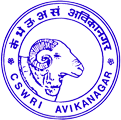Network Project on Sheep Improvement
 | |
| Type | ICAR Network Project |
|---|---|
| Established | 1991 |
| Affiliation | ICAR |
Officer in charge | Dr. S. M. K. Naqvi |
| Location |
Malpura, Rajasthan, India 26°17′N 75°23′E / 26.28°N 75.38°E |
| Campus | Avikanagar |
| Nickname | NWPSI |
| Affiliations | Indian Council of Agricultural Research and Central Sheep and Wool Research Institute |
| Website | CSWRI |
ICAR - Network Project on Sheep Improvement (NWPSI)
Network Project on Sheep Improvement (NWPSI)[1] was initiated on to undertake survey, evaluation and improvement of indigenous sheep breeds (Indian) under native environment by Indian Council of Agricultural Research [2](ICAR), India. Different breeds of sheep are being improved through selection and inter-se mating for wool and mutton production. The mandate of NWPSI is genetic evaluation and improvement of indigenous sheep by selection. Presently, there are six ongoing centres of NWPSI including four farm based units and two field based units located at difference parts of the country.[3]
Coordination Cell: Project Coordinator Cell, NWPSI, Central Sheep and Wool Research Institute[4], Avikanagar, Rajasthan, India Coordinated under the guidance of Dr.S.M.K.Naqvi, Director, CSWRI and Project Coordinator (Sheep Breeding), CSWRI,Avikanagar, Rajasthan,India.
Cooperating Units:
A. Farm based Cooperating units
1.ARC (ICAR-CSWRI), Bikaner - Marwari sheep for Carpet Wool
2.ICAR-CIRG, Makhdoom - Muzaffarnagri sheep for Dual purpose[5]
3.MPKV, Rahuri - Deccani sheep for Dual purpose[6]
4.SVVU, Palamner - Nellore sheep for Mutton[7]
B. Field based Cooperating units
1.TANUVAS, Kattupakkam - Madras Red sheep for Mutton [8][9]
2.ARC (ICAR-CSWRI), Bikaner- Magra Sheep for Carpet wool
The objectives of NWPSI is Genetic improvement of indigenous sheep breeds by selection. The technical programme aims at improvement of indigenous sheep breeds under farm conditions wherein the male lambs are first ranked using selection index. Index incorporates body weight and wool yield at six months of age. Each field-based unit has four centres including a ram-rearing centre, covering a sheep population of about 1500 sheep per centre. The superior male lambs are selected from the farmers’ flocks on the basis of GFY1 and 6-month body weigh in Magra sheep and on six-month body weight basis in Madras Red sheep. Male lambs are initially identified at 3 month of age and are finally selected after first shearing. Selected male lambs from improver flocks are supplied for breeding to base flocks.[10]
Breeding rams of high breeding value are produced from farm based unit every year for germplasm distribution. During the XI plan period about 900 improved breeding rams/ram lambs from five Farm Based Units were sold to different farmers/ State Govt/ NGOs for breed improvement programme and about 700 breeding rams / ram lambs were distributed in three Field Based Units for improvement of farmers flock. The Sheep Improvement Programmes will continue and efforts will be made to bring overall improvement in sheep productivity through distribution of superior germplasm and adoption of improved scientific management practices.
Source http://cswri.res.in/network_project_on_sheep_improvement.asp https://www.facebook.com/NWPSI http://cswri.res.in http://www.icar.org.in http://www.cswri.res.in/downloads_NWPSI.asp PC Annual Report (2013–14) published by ICAR-CSWRI, Avikanagar, Rajasthan India (http://www.cswri.res.in/upload/NWPSI-PC-Annual-Report-2013-14.pdf)
for more information Sheep breeding programmes in India: A review [11]
References
- ↑ http://cswri.res.in/network_project_on_sheep_improvement.asp
- ↑ http://www.icar.org.in
- ↑ http://www.icar.org.in/files/reports/icar-dare-annual-reports/2013-14/live-stock-improvement-13-14.pdf
- ↑ http://cswri.res.in
- ↑ http://www.cirg.res.in/internal_pro.php
- ↑ http://mpkv.ac.in/Pages%20inner%20for%20Print.pdf
- ↑ http://svvu.edu.in/res_stns.html
- ↑ http://krishikosh.egranth.ac.in/handle/1/2056758
- ↑ http://www.tanuvas.tn.nic.in/pgrias_schemes.html
- ↑ http://www.cswri.res.in/upload/NWPSI-PC-Annual-Report-2013-14.pdf
- ↑ http://www.indianjournals.com/ijor.aspx?target=ijor:ijsr&volume=18&issue=1&article=001